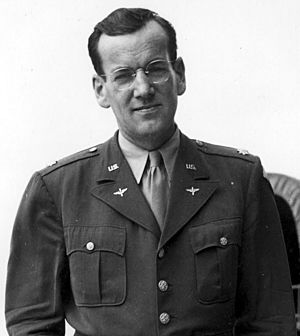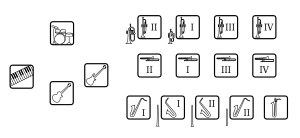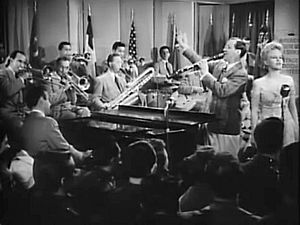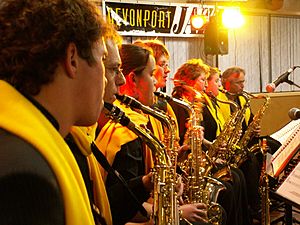Big band facts for kids
Quick facts for kids Big band |
|
|---|---|

Paul Whiteman and his orchestra in 1921
|
|
| Stylistic origins | |
| Cultural origins | 1910s |
| Derivative forms |
|
A big band is a type of musical group that plays jazz music. These bands were very popular in the 1930s and 1940s. A big band usually has between 12 and 25 musicians. They often include a singer and people who play instruments. Some instruments are saxophones, trumpets, trombones, and drums.
Some famous big band leaders were Duke Ellington, Benny Goodman, Glenn Miller, Cab Calloway, and Count Basie. Big bands first started to play music for dancing. Unlike other jazz groups that focused on musicians making up music on the spot, big bands used written songs and arrangements. This meant the bandleaders and different sections of instruments played a bigger role than individual soloists.
Contents
What Instruments Do Big Bands Use?
Big bands usually have four main groups of instruments. These are the trumpets, trombones, and saxophones. They also have a rhythm section. This section includes a guitar, piano, double bass, and drums.
Today, some big bands can be much larger. They might have more than 20 players. Some bands in Europe even use 29 instruments. A few can even reach 50 musicians!
The History of Big Bands
Big Bands and Dance Music
Before 1910, dances like the waltz and polka were popular in America. As jazz music moved from New Orleans to cities like Chicago and New York, new energetic dances came with it. In the years that followed, dance halls were filled with people doing the jitterbug and Lindy Hop. The dance team Vernon and Irene Castle helped make the foxtrot dance famous. They danced to music played by the Europe Society Orchestra. This orchestra was led by James Reese Europe.
One of the first bands to play for these new dances was led by drummer Art Hickman. This was in San Francisco in 1916. Hickman's arranger, Ferde Grofé, wrote music that split the jazz orchestra into different sections. These sections would play together in many ways. This mixing of sections became a key part of what made big bands special.
In 1919, Paul Whiteman hired Grofé to use these ideas for his own band. Whiteman had studied classical music. He called his band's new music "symphonic jazz." These dance band methods were different from the older New Orleans jazz style. Most bandleaders started to create their own big bands. They added parts of Broadway, Tin Pan Alley, ragtime, and vaudeville music.
Duke Ellington led his band at the famous Cotton Club in Harlem. Fletcher Henderson started his career when he got a job as a bandleader at the Roseland Ballroom in New York City. At these popular places, bandleaders and arrangers became more important than before. Henderson and his arranger Don Redman changed jazz. They had a very talented band. It included Coleman Hawkins on tenor saxophone and Louis Armstrong on cornet. Benny Carter, who played many instruments, also played with them. His career lasted into the 1990s!
The Swing Era: Big Bands Take Off!
Swing music started to appear in the early 1930s. This type of music grew through the early 1930s. However, not many people listened to it until around 1936. Before that, some people even made fun of it. After 1935, big bands became very popular. They played swing music and helped define it as a unique style. Western swing musicians also formed popular big bands during this time.
There were many different styles among the hundreds of popular bands. Many well-known bands showed the unique style of their bandleader, main arranger, and musicians. Count Basie played a relaxed, driving swing. Bob Crosby played more of a dixieland style. Benny Goodman played a hard-driving swing. Duke Ellington's songs were varied and complex.
Many bands featured strong musicians whose sounds stood out. These included the clarinets of Benny Goodman and Artie Shaw. Also, the trombone of Jack Teagarden, the trumpet of Harry James, the drums of Gene Krupa, and the vibes of Lionel Hampton. The popularity of many big bands grew because of their star singers. These included Frank Sinatra with Tommy Dorsey. Also, Helen O'Connell and Bob Eberly with Jimmy Dorsey. Ella Fitzgerald sang with Chick Webb. Billie Holiday and Jimmy Rushing sang with Count Basie. Doris Day sang with Les Brown. Peggy Lee sang with Benny Goodman.
By this time, big bands were so strong in jazz that older musicians had to change their style or stop playing. There was no market for small jazz groups. So, musicians like Louis Armstrong led their own big bands. Others, like Jelly Roll Morton, became less known.
Major "black" bands in the 1930s included Ellington's, Hines's, Calloway's, Jimmie Lunceford's, Chick Webb's, and Count Basie's. "White" bands like Benny Goodman's, Artie Shaw's, Tommy Dorsey's, and Glenn Miller's became more popular than the "black" bands by the mid-1930s. The Casa Loma Orchestra and Benny Goodman's early band helped connect white audiences to this music.

Teenagers and young adults were the main fans of big bands in the late 1930s and early 1940s. They danced to records and radio music. They also went to live concerts. Big bands helped lift spirits during World War II. Many musicians joined the military. They toured with USO groups to entertain soldiers. Glenn Miller even died while traveling between shows. Many bands lost musicians during the war. Their music quality at home sometimes dropped.
A strike by musicians from 1942 to 1944 made things worse. Singers started to leave bands and perform on their own. By the end of the war, swing music was changing. Less danceable music, like bebop, became popular. Many great swing bands broke up as times and tastes changed.
Modern Big Bands Today
Even though big bands are known for the swing era, they still exist today. The music they play is often different from old swing. In the 1950s through the 1970s, the Basie and Ellington bands were still playing. Other bands were led by Buddy Rich, Gene Krupa, Lionel Hampton, Earl Hines, Les Brown, Clark Terry, and Doc Severinsen. New, experimental bands were led by Dizzy Gillespie, Gil Evans, Carla Bley, Toshiko Akiyoshi and Lew Tabackin, Don Ellis, and Anthony Braxton.
In the 1960s and 1970s, "big band rock" became popular. This music mixed progressive rock, jazz fusion, and the horn sections often used in blues and soul music. Some famous groups included Chicago, Blood, Sweat and Tears, and Tower of Power. This style slowly became part of regular pop rock and jazz rock.
Today, modern big bands play all kinds of jazz music. In the late 1990s, there was a "swing revival" in the U.S. The Lindy Hop dance became popular again. Young people became interested in big band styles once more. Big bands have also stayed on American television. Late-night talk shows often use big bands as their house bands.
Big Bands in Movies
Big bands started to appear in movies in the 1930s through the 1960s. Sometimes, bandleaders would make short appearances. Fictional movies about the lives of Glenn Miller, Gene Krupa, and Benny Goodman were made in the 1950s.
Bands led by Helen Lewis, Ben Bernie, and Roger Wolfe Kahn were filmed in 1925. These were short films using a special sound-on-film process. These films are now kept in the Library of Congress film collection.
Images for kids
See also
 In Spanish: Big band para niños
In Spanish: Big band para niños






